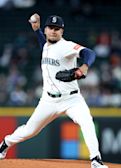The pros and cons of 6 top SP trade candidates
Garrett Crochet’s move to the Red Sox may not be the last trade we see this offseason involving a big-name starting pitcher.
With the prices for free-agent arms soaring and the options continuing to dwindle, trade rumors have been swirling around a number of top arms.
MLB offseason signings and trades
• Latest free-agent and trade rumors
• Top 25 free agents | Every free agent, by position
• Tracking every team's offseason moves
• FA guides: Burnes | Alonso | Bregman | Santander
• Offseason dates, rules & terms explained
Here’s a look at six intriguing starters whose potential availability could shake up the market.
Luis Castillo, Mariners
Contract situation: signed through 2027 (owed roughly $72 million) with $25 million vesting option for 2028
Why Seattle could trade him: The Mariners are loaded with controllable young arms, which could make their most expensive starter expendable as they look to create some financial flexibility to add a big bat. Seattle’s offense ranked 21st in the Majors in runs scored (676) and 25th in slugging percentage (.376) last season.
Pros: Castillo looked the part of an ace in 2022-23, recording the 10th-best ERA (3.19) and the ninth-best WHIP (tied at 1.09) among pitchers with at least 300 innings in that span. He also had the 10th-largest difference (20.1 percentage points) between his strikeout and walk rates in that same group of hurlers. Castillo was a bit wild earlier in his career (3.3 BB/9 from 2017-21), but he has cleaned up that aspect of his game over the past three years (2.5 BB/9).
Cons: The 2024 season was a step down for Castillo, who not only recorded a 3.64 ERA but also saw his whiff rate (down 4.7 points) and strikeout rate (down 3.0 points) drop by a significant margin from the previous year. Any team looking to acquire him would also need to weigh the financial commitment, because Castillo is guaranteed around $72 million over the next three years, making him the most expensive pitcher in this group.
Dylan Cease, Padres
Contract situation: arbitration eligible (controllable through 2025)
Why San Diego could trade him: Padres general manager A.J. Preller showed a willingness to be proactive last offseason, trading Juan Soto (and Trent Grisham) to the Yankees for five players a year before Soto was set to reach free agency. Two of the players the Padres received in that deal -- Michael King and Kyle Higashioka -- became key contributors for San Diego in 2024. Preller used another piece from the trade, prospect Drew Thorpe, in a package to acquire Cease. Now, with Cease set to become a free agent at the end of the 2025 campaign, Preller could look to make a similar move and take advantage of the demand for affordable starters by dealing the right-hander ahead of time.
Pros: Cease misses a ton of bats, ranking third among pitchers (minimum 400 batters faced) with a 32.4% whiff rate and ninth with a 29.4% strikeout rate in 2024, his fourth straight season with more than 200 K’s. He gets many of those strikeouts with his elite slider, which was one of MLB’s most valuable pitches last season, as rated by Statcast’s run value metric. Cease is also quite durable, joining Aaron Nola and José Berríos as the only pitchers to make at least 32 starts in each of the past four years.
Cons: Cease’s penchant for walking batters (lifetime 3.8 BB/9) means he can be prone to inconsistency. His dramatic ERA fluctuation over the past four years -- 3.91, 2.20, 4.58, 3.47 -- is evidence of that. In 2024 alone, he had three months with a sub-3.00 ERA but posted an ERA north of 4.00 in the other three months.
Sonny Gray, Cardinals
Contract situation: signed through 2026 (owed $60 million) with $30 million club option ($5 million buyout) for 2027
Why St. Louis could trade him: After missing the playoffs in each of the past two years, the Cardinals are in a transition period. The team plans to prioritize strengthening its player development pipeline under advisor Chaim Bloom, who is set to succeed John Mozeliak as president of baseball operations in 2026. These efforts are expected to involve reduced spending on the Major League roster, potentially leading St. Louis to deal away veterans such as Gray, although the right-hander holds a full no-trade clause.
Pros: While Gray’s ERA increased by more than a run from 2023 (2.79) to 2024 (3.84), some of his underlying metrics paint a much rosier picture of his performance. Among qualifying pitchers, Gray’s 3.12 FIP was seventh best, and he had the third-largest difference (24.4 points) between his strikeout rate and walk rate -- trailing only the two Cy Young Award winners, Chris Sale and Tarik Skubal. Since his rocky stint with the Yankees, Gray has recorded a 3.35 ERA with 935 strikeouts over 836 2/3 innings spanning 152 starts for the Reds, Twins and Cardinals.
Cons: Gray, 35, is the oldest pitcher on this list, so it's fair to wonder how much longer he can continue to perform at such a high level. The right-hander is under contract through his age-37 season on a heavily backloaded deal, with $65 million guaranteed to him over the next two years (including the $5 million buyout on his 2027 club option). It’s also tough to count on Gray to stay healthy for a full season; he has reached the 30-start plateau only twice in the past nine years after doing so in each of his first two full seasons (2014-15).
Jesús Luzardo, Marlins
Contract situation: arbitration eligible (controllable through 2026)
Why Miami could trade him: Facing a rebuild that is likely to go beyond Luzardo’s window of team control, the Marlins are expected to explore the left-hander’s trade value this offseason. Luzardo likely would have been dealt prior to the 2024 Trade Deadline if not for an injury.
Pros: A former top prospect, Luzardo demonstrated his potential in 2022-23, ranking ninth in whiff rate (31.5%) and 15th in strikeout rate (28.8%) among starting pitchers who faced at least 500 batters during that span. He had with a solid 3.48 ERA over those two seasons. At just 27 years old, Luzardo is also the youngest player on this list, leaving room for the possibility that his best is yet to come.
Cons: Injuries have cost Luzardo a considerable amount of time since his debut in 2019. Last season, he was sidelined by left elbow tendinitis early in the year and was later shut down for the season with a lumbar stress reaction in his back. The southpaw threw just 66 2/3 innings on the year, and the results weren’t encouraging: His ERA ballooned to 5.00 while his strikeout rate plummeted to 21.2%. Luzardo’s velocity was also down a tick, and he had trouble missing bats with his four-seam fastball, posting the sixth-lowest whiff rate (11.1%) on four-seamers in MLB (minimum 150 swings on four-seamers).
Jordan Montgomery, D-backs
Contract situation: signed through 2025 (owed $22.5 million)
Why Arizona could trade him: After D-backs owner Ken Kendrick said at the end of the season that signing Montgomery in free agency was a mistake, it wouldn’t be a surprise to see the team make an effort to trade the left-hander, who exercised his $22.5 million player option on the heels of a 6.23 ERA over 117 innings in 2024.
Pros: Montgomery's rough 2024 season was a significant departure from his strong performance across 2021-23, during which he posted a 3.48 ERA over 94 starts. He also rose to the occasion for the Rangers on the postseason stage in 2023, helping Texas win the World Series with a 2.90 ERA over 31 innings in those playoffs. Given his past success, it's reasonable to pin the blame for Montgomery's struggles last season on his lack of a proper buildup, having signed with Arizona so close to Opening Day.
Cons: Montgomery may be a realistic candidate to rebound, but any team interested in acquiring him is going to have to make a $22.5 million bet (minus any money covered by Arizona) that he can do so. That's not an easy proposition, considering he pitched to an ERA over 6.00 in 2024 while experiencing a dip in velocity. Though the late signing date may have contributed to his ineffectiveness, it’s hard to overlook how far his strikeout rate plummeted last season, dropping nearly six percentage points from 2023. At just 15.6%, he ranked third worst among pitchers who logged at least 100 innings. Montgomery has never been a big strikeout pitcher, but this level of decline is a concern.
Framber Valdez, Astros
Contract situation: arbitration eligible (controllable through 2025)
Why Houston could trade him: Like the Padres with Cease, the Astros could consider dealing Valdez as a proactive move before he potentially departs as a free agent next offseason. Houston reached a deal to send another upcoming free agent, outfielder Kyle Tucker, to the Cubs on Friday, days after Astros general manager Dana Brown said at the Winter Meetings that the team is receptive to trading anyone.
Pros: As a 5-foot-11 sinkerballer, Valdez doesn’t look the part of a prototypical frontline starter, but it’s hard to argue with the results. The lefty is tied for seventh in ERA (3.12) among pitchers with at least 500 innings going back to his 2020 breakout season, thanks in large part to a sky-high ground-ball rate (62.9%). Valdez has thrown 781 innings during that time, the seventh most in MLB.
Cons: Although Valdez can use his curveball and changeup to miss bats, his heavy reliance on his sinker to generate ground balls means that batted-ball luck and the defensive support behind him can have an outsized impact on his performance. Valdez is also prone to allowing hard contact -- his 45.0% hard-hit rate last year ranked in the sixth percentile -- which doesn’t matter as much when that contact comes on the ground but can be damaging when it’s in the air.


